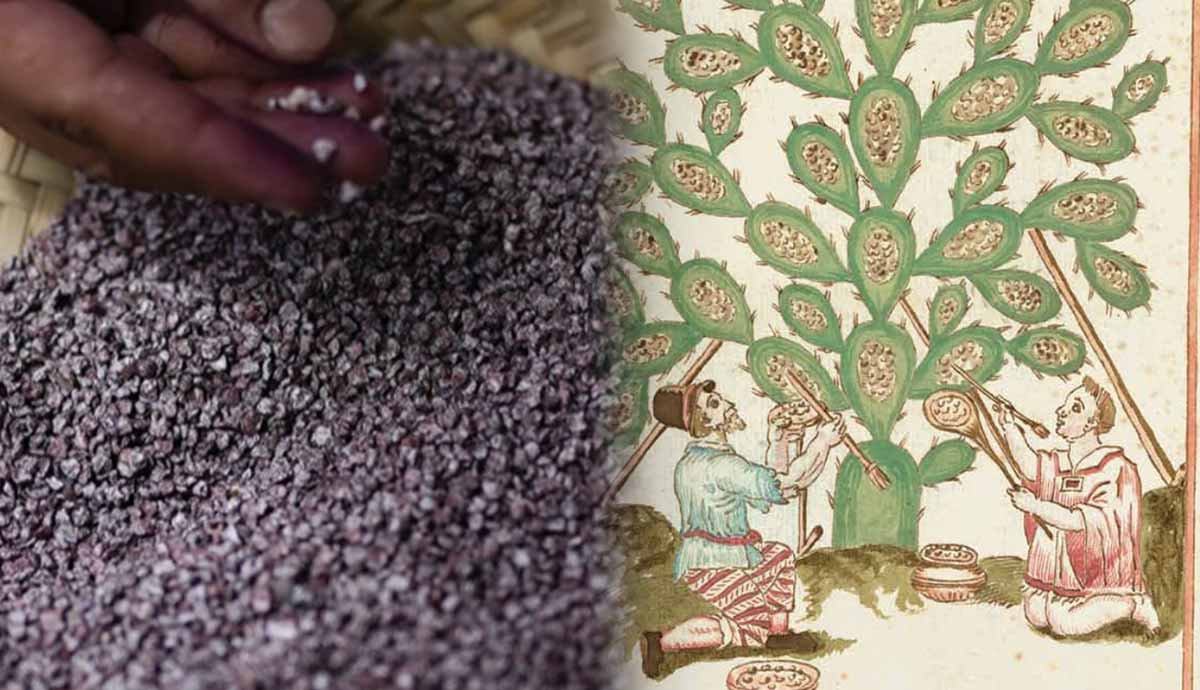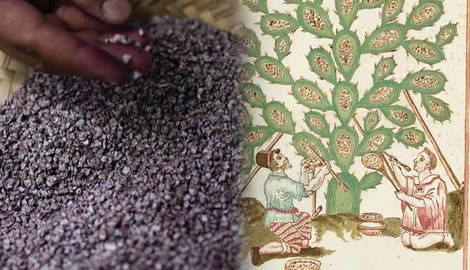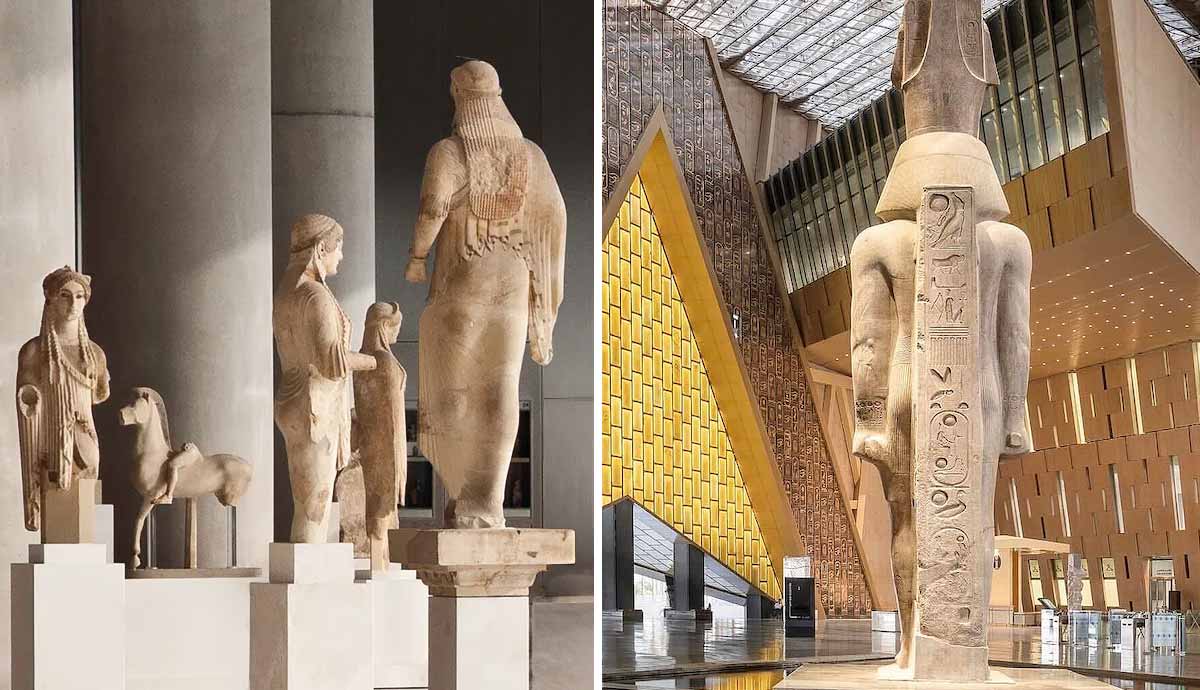
summary
-
Cochineal insects on nopal yield carmine red, revered in Mesoamerica and still coloring foods, cosmetics, textiles, and art.
-
Spain commercialized cochineal after the conquest: Oaxaca became a global hub; the dye colored masterpieces and British redcoats.
-
Labor-intensive production (~70,000 insects/kg) endures; Indigenous artisans revive natural dyes as synthetic risks mount worldwide.
A dye extracted from crushed bugs might sound archaic, but it is surprisingly ubiquitous. Cochineal—parasitic insects that live on nopal (prickly pear) cacti across Latin America—are the key ingredients in a vivid red pigment known as carmine, which colors foods, beverages, cosmetics, and pharmaceuticals today. In Oaxaca, its production has occupied the heart of indigenous cultures since as early as 2000 BCE. Following colonization, cochineal became a prized commodity in Europe and one of Mexico’s largest commercial exports. Even today, its legacy is felt across the globe.
The Pre-Columbian Origins of Cochineal

Long before Spanish colonizers first set foot on the American continent, cochineal red was held with the same reverence as gold and silver amongst the sophisticated indigenous civilizations of ancient Mesoamerica.
The Aztec, Zapotec, and Mixtec peoples of western and south-central Mexico, in particular, were known to associate the dye’s rare color with ancestral magic and protection. According to pre-Columbian legend, nocheztli (the Nahuatl name for cochineal, meaning cactus blood) was originally born out of the blood shed by two quarreling gods across a field of nopal cactus.
An early Mexican codex, the Matrícula de tributos, documents the use of cochineal as a kind of bargaining currency, or tribute, to Aztec rulers. In everyday life, the pigment was used for both sacred and mundane purposes: to dye clothing, feathers, and textiles; in offerings and ceremonies; and even as a cosmetic stain for women’s teeth. It was also commonly used for painting codices and mural art—traces of which can still be found amongst the ancient remains of some Mexican archaeological sites today.
Cochineal produced a vibrant, lasting hue unlike any other, achieving a range of soft pinks, lush scarlets, and deep burgundies that were incomparable to any other natural dye of the time. As its popularity grew, the Oaxaca Valley region became a hub for the production and trade of the pigment. Before long, Mixtec farmers in the neighboring highlands began domesticating cochineal insects, breeding bugs with traits favorable for making the brightest, most stable dyes.
What’s in a Color?

While demand for cochineal expanded dramatically over time, much of its traditional production process has remained remarkably intact. Even today, nopalerias (large-scale cactus farms) are used to cultivate and harvest cochineal insects across Mexico.
Producing the pigment itself is a slow and laborious process—about 70,000 bugs are required to make each kilogram of dye. The insects themselves are soft-bodied and live in clumps on the pads of nopal cacti. Only the females and their eggs produce carminic acid, the source of the cochineal’s signature red coloring.
Every 90 days or so, traditional nopaleria farmers carefully knock thousands of insects and their eggs from the pads of their cacti hosts using a tiny brush. The insects are first boiled, then cleaned and dried in the sun’s heat, reduced to less than a third of their original body weight. Dried cochineal is then ground—either by hand or using mills—into a fine powder. Finally, this resulting powder is mixed with salts which help isolate the carmine, which can then be used with a mordant for dyeing.
This ancestral art is still alive and well in some parts of Mexico—particularly in modern-day Oaxaca, a colonial city practically built by the prosperity of the cochineal trade. Though synthetic dyes are increasingly chosen as a cheap and convenient modern alternative, many artisans in Oaxaca continue to favor organic pigments like cochineal for traditional handicrafts, including textile weaving.
Commercializing Cochineal: Spanish Colonization

When Spanish colonizers arrived in what is today Mexico in the early 16th century, cochineal’s already well-established importance to the region’s indigenous cultures and mythologies was utterly transformed.
Back in Europe, there were only a few viable options for red dye, and most faded quickly or were overly complicated to produce. Red hues were particularly expensive due to their limited availability, which, of course, made them all the more sought after by European monarchs and aristocrats.
Upon their arrival, Spanish colonizers were awestruck by the brilliance of the cochineal dye they noticed for sale in local marketplaces. Duller European pigments (like madder root, henna, lac, and kermes, for instance) seemed to pale in comparison to the bright, saturated color and impressive durability of cochineal.
Sensing an opportunity for profit, they shipped dried samples of the dye back to Spain and set about capitalizing upon existing local methods for cochineal production in order to export as much of the pigment to mainland Europe as possible. Hundreds of tons of dried cochineal were exported across the Atlantic with the hopes of kindling its potential as a lucrative trade business on the European continent.

As predicted, cochineal became an instant international sensation. By the 18th century, it was second only to silver as Mexico’s most valued export and had nearly supplanted all other red dyes. Its trademark color quickly became a recognizable symbol of power and prestige across Europe, though its vast trade routes ultimately expanded as far afield as Asia and the Middle East.
As the popularity of cochineal spread around the world, it was adopted for a variety of new uses. Some of the most renowned European artists of the time—Antony van Dyck, Peter Paul Rubens, Domenikos Theotokopoulos (El Greco), and Rembrandt van Rijn, to name a few—adopted the pigment into their palettes in favor of its vivid, translucent quality. The cochineal was combined with a binder to produce a pigment known as a lake, leading to an end product that was incredibly potent and versatile.
Famously, cochineal red was also the color used for traditional British redcoats—the iconic woolen jackets worn by the British army from the 17th to the late 19th century. While most of the lower regiments wore uniforms dyed with madder root (a cheaper, rustier-appearing dye), the color of choice for the coats of sergeants and officers was a scarlet hue that could only be achieved with cochineal.

With the aim of maintaining a strict monopoly over the valuable dye, Spain kept the details of cochineal production a closely guarded secret. It was forbidden by law to bring live insects outside the borders of Spanish colonial territory, and foreigners were prohibited from visiting Spanish colonies. As a result, the exact means by which the dried dye was made—and even what it was made of—was a mystery to the outside world. For years, consumers and competitors abroad speculated as to what ingredient was behind the dye’s signature bright red color.
This secrecy allowed the Spanish to keep a firm and exclusive grasp on the cochineal trade. Even after English and French spies determined the dye’s origin, it proved nearly impossible to successfully grow cochineal outside of the Americas—one after another, attempts to bring the live insect abroad failed. The world remained dependent on Spain for its favorite dye for nearly three centuries, supporting the Spanish economy and helping to finance its sprawling empire.
Oaxaca as Mexico’s Cochineal Capital

Cochineal was produced almost exclusively in Oaxaca during the colonial era. Indigenous people living in conquered communities were forced to work tirelessly for little pay to meet the increasingly insatiable global demand for the dye. Some 30,000 workers were employed in dye production in the Oaxaca Valley.
Spain’s control of Mexico’s cochineal trade was, like most other colonial initiatives, extractive and exploitative. Indigenous people were given little (if any) credit for the complex production process they developed, which the Spanish Crown claimed as its own to the outside world. What’s more, the native populations involved in producing cochineal saw almost none of the profit it generated despite the enormous amount of labor they expended.
What local Oaxacans did receive, though, was a legacy of skilled artisanship that would outlast colonial rule by centuries. Much of Oaxaca was built by the wealth of the cochineal trade, which in turn helped complementary artisan industries like textile production to blossom and thrive. These rich and diverse artisan traditions are now, somewhat ironically, an essential part of the region’s cultural autonomy and local economies. It is hard to imagine what Oaxaca would be like without them.

Today, commercial cochineal farming is found not only in Mexico but across Peru, Chile, Argentina, and the Canary Islands. Yet the state of Oaxaca has kept its place at the heart of cochineal production, even to this day. Even as cheap, mass-produced synthetic dyes have come to dominate the global market, many Oaxacan artisans have preferred to continue working with cochineal for their handicrafts. More recently, as research has begun to point to the potential hazards of certain chemical dyes, natural pigments like cochineal are experiencing a noticeable revival.
In Oaxaca—and in greater Mexico, for that matter—cochineal red is more than just a color. The dye’s story has become inextricably linked with the complex pre and post-colonial histories of the region, as well as with the origins of Oaxaca as it is known today.










